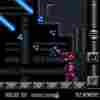
Nintendo’s Switch console is less powerful than competing consoles, but offers a more interesting gameplay experience.
Drew Angerer/Getty Images
hide caption
toggle caption
Drew Angerer/Getty Images
Nintendo’s Switch console is less powerful than competing consoles, but offers a more interesting gameplay experience.
Drew Angerer/Getty Images
When Gennadiy Korol, lead engineer at Moon Studios, booted up Ori and the Will of the Wisps on his Xbox, his eyes lit up. He and his team of developers at Moon Studios had worked tirelessly: coding, testing, and optimizing. Finally, after months of chugging espresso, a thing of video game beauty beamed back at him.
Ori and the Will of the Wisps was ready.
For the Xbox, that is. Another console told a different story. The Nintendo Switch version of Ori looked, well … different.
Since the start of the COVID-19 pandemic, Nintendo Switch sales have exploded and some developers have been intent on getting their games into the Nintendo eShop.
According to Korol, however, actually creating a Switch version of your game, especially one as graphically-rich as Ori, is time-consuming and frustrating.
Some background on the Nintendo Switch: It isn’t as powerful as other video game consoles. Without going down a rabbithole of techie language, it has trouble processing certain games at 60 frames-per-second; that’s usually what’s needed for high-quality gameplay. Bringing that capability to the Switch is like summarizing Shakespeare; you’ll get the gist of what’s going on, but you won’t get that gorgeous rhythm and poetry.
But bringing a complex game like Ori to the Switch, although not easy, is certainly possible.
“We had a rock-solid frame-rate on the Xbox,” says Korol. “We thought ‘Awesome! We’ve invested all this time on the Xbox; now we can start the Switch port. So we run it and it starts at, like, 24 FPS.”
Not great and not even close to 60 FPS. On the Nintendo Switch, Ori started with some disheartening choppy graphics and stuttering gameplay, not at all how the game is supposed to look.
“That was already after a few months of hard optimization [for the Xbox],” said Korol. “How can we push this to 60 [FPS]?”
The answer isn’t super fancy: You program, you test, and you program some more.
“When you’re optimizing a game like this on a platform that is so weak, [and] you wanna get 60 [FPS], it’s an ‘all-or-nothing’ approach,” says Korol. “Some of us just like the challenge.”
Nintendo has never been known for making powerful consoles. When it comes to pixel-perfect graphics and buttery gameplay, Sony’s Playstation and Microsoft’s Xbox are the two consoles in a constant duel, but Nintendo doesn’t seem to care. For years, Nintendo has instead focused on “new experiences and gameplay” according to their hardware director, Ko Shiota.
“We don’t only chase trends in technology,” Shiota said in a Q&A with investors.
He’s right. Take the Switch: It’s unlike any console we’ve ever seen. Not only can you play it on a TV like a “normal” console, but you can undock it from its power supply and play in hand-held mode on its built-in screen. And it’s not as if Nintendo is falling short of its competition; Switch sales have only grown since its release in 2017.
And unlike Moon Studios, whose decision to bring Ori to the Switch came months after the game was initially released, other game developers were fully prepared to bring their games to Nintendo’s console.
Supergiant Games, developers of the highly-anticipated title Hades, released their game on September 17th for both PC and the Nintendo Switch
“Bringing Hades to the Switch was a similar process to bringing our other games to console,” says Andrew Wang, Chief Technology Officer at Supergiant Games. “The Switch specifications are well within the range of our targeted PC specifications, and we planned for it from the start.”
Just because Supergiant planned on porting Hades to the Switch doesn’t mean it was a cakewalk. After all, a video game is a work of art and porting it to a new console is complex. It’s like a painter spawning several variations of a composition or a novelist writing different drafts of their story.
“Porting and optimizing it [was] always going to be a challenge … Getting any game ‘stood up’ on a new platform is never a simple task,” says Wang. “But it was a question of time more than possibility.”
Even though developing a game for the Nintendo Switch is challenging, Moon Studios and Supergiant Games alike were excited about bringing their art to the innovative console.
“We just love the Switch,” says Gavin Simon, development director and co-founder of Supergiant Games. “Personally it’s where I do almost all my gaming these days… [so] it was super exciting to be able to include the Nintendo Switch as one of our launch platforms.”
It’s easy to see why game developers are ready to bring their games to the Switch. They want to be part of a console that prioritizes interesting new gaming experiences, not just raw power, even if that means spending months optimizing for a weaker system. Gaming doesn’t just have to be about hyper-realistic graphics, and sometimes it feels like that’s the sole focus for big companies like Sony or Microsoft.
After absorbing Ori and the Will of the Wisps, fans will be thirsting for a sequel (or standalone game) that lets them escape all this real-world mayhem and scour a new mystical realm. When I asked Moon Studios’ Korol when fans can expect a third game, he asked, “A third game or a third Ori game?” Either way, another challenge awaits the developers; the Switch will be around for a while, and bringing a new game to it could be just as baffling.
Whatever this mystery project is, Korol says “it will be worth the wait.”
Keller Gordon is a columnist for Join The Game. Find him on Twitter: @kelbot_








